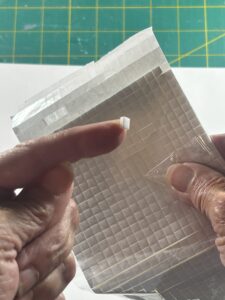Adhesives are the most important building blocks of scrapbooking. Without them, we wouldn’t be able to create our albums that tell rich stories of our family history. Back in the early days of scrapbooking, our grandmothers and mothers used clear cellophane tape, white glue, and photo corners. Today, science and technology has improved adhesives so that you can repair, adhere, and stick just about anything. But it can still be a bit confusing of which to use. So, which is preferred: Tape or Glue?
Actually, I use both. But let’s take a closer look Tape vs Glue so you can make an informed choice of using one of them or both of them for creating your scrapbook. But first, remember to read the labels and make sure the product is acid free. Acid is not your photographs’ friend. Acid will destroy photos over time, so you want to look for phases on the label like: “acid free”, “archival safe”, or “pH neutral.”

Tape runners come is several sizes, but generally are two-sided tape that are contained in a plastic shell dispenser with a rolling front. When the rolling dispenser is pressed and dragged along the paper or photo, it leaves a stripe of adhesive. Tape runners are quick to use, fairly inexpensive and work well if your paper is textured.
Double-sided tape comes in rolls. You cut the tape to the desired length, apply it to the paper or photo and peel off the backing to reveal the adhesive on the other side. You can get widths of double-sided tape from 1/8 inch to 8 1/2 x 11- inch sheets. Double-sided tape can be more expensive. I use double-sided tape mostly in my crafting of scrapbook albums more than for sticking down photos in a scrapbook.

Glue dots and foam squares are also options of tape that work well (read the labels). The foam squares add dimension to the page and are fun to use. The foam lifts photos or embellishments up just a bit to allow for layering and works well when creating frames or collages.
I need to mention here that you should consider having photo corners in your adhesive stash. They are important if you want to make a true archival scrapbook where the photos can be removed from their page to be repaired, copied or reproduced. I will make archival scrapbooks with family photos from years past of multiple families pictured, using photo corners to keep them safely on the scrapbook page. That way, if my cousin would like a copy of a photograph, I can remove it and make copies. For trips with my immediate family, like a family trip, I tend to use glue or tape to stick down the photos or memorabilia for a more permanent placement.

Wet glue too has improved through the decades. But many scrapbookers complain that wet glue warps paper and photographs. I’ve had this happen to me. To keep the warping to a minimum, be frugal with your glue. In other words, use a small about. Glue spreads to the area around it so a little goes a long way. And in general, glue is thought to be more permanent than tape over time.
When you purchase acid-free glue, look for those that dry clear instead of opaque. Glues for “general purpose” like from your child’s art stash may have colors added to them and wouldn’t be good for your scrapbook. One advantage to using glue, though, is that you have a little wiggle room, literally. Once the glue is applied, the photo or embellishment can be repositioned for a few seconds before the glue “catches”. This has saved me more than once from making mistakes.
So, I hope I’ve given you enough information that you know what to look for. But you’re not sure where to shop for scrapbook supplies? The major big box stores and Amazon are a good start. All of them have supplies that you can use. There are smaller specialty stores too that you can discover by putting “scrapbook supplies” in your search engine. If you are just beginning your scrapbooking journey, spend the time to look for products you feel comfortable purchasing to protect your treasures. But don’t spend a ton of money. You’ll use small amounts of glue, tape, photo corners, and foam squares in each scrapbook. Start small to see what works best for you.
Happy Scrapbooking!
